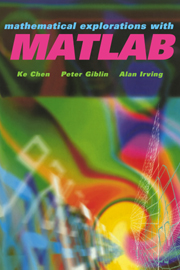Book contents
- Frontmatter
- Contents
- Preface
- Part one Foundations
- Part two Investigations
- Part three Modelling
- Appendix 1 MATLAB Command Summary
- Appendix 2 Symbolic Calculations within MATLAB
- Appendix 3 List of All M-files Supplied
- Appendix 4 How to Get Solution M-files
- Appendix 5 Selected MATLAB Resources on the Internet
- References
- Index
Appendix 5 - Selected MATLAB Resources on the Internet
Published online by Cambridge University Press: 08 February 2010
- Frontmatter
- Contents
- Preface
- Part one Foundations
- Part two Investigations
- Part three Modelling
- Appendix 1 MATLAB Command Summary
- Appendix 2 Symbolic Calculations within MATLAB
- Appendix 3 List of All M-files Supplied
- Appendix 4 How to Get Solution M-files
- Appendix 5 Selected MATLAB Resources on the Internet
- References
- Index
Summary
The name MATLAB stands for matrix laboratory. MATLAB was originally written to provide easy access to matrix software developed by the LINPACK and EISPACK projects, which together represent the state of the art in software for matrix computation. MATLAB converts user commands (including M-files) into C or C++ codes before calling other program modules (subroutines). Today MATLAB has been developed to cover many application areas. You may search the internet with the key word MATLAB to see some evidence. To learn more about the product developers, check the web page
http://www.mathworks.com/
If you hope to find out more of, or wish to use directly, the LAPACK and EISPACK programs, check the following
http://www.netlib.org/lapack/
For users who would like a gentle and easy introduction to MATLAB, try the following
http://www.ius.cs.cmu.edu/help/Math/vascJielp-matlab.html
http://www.unm.edu/cirt/info/software/apps/matlab.html
For novice users who prefer short guides to MATLAB with concrete and simple examples, try
http://www.liv.ac.uk/CSD/acukJitml/486.dir/486.html
http://www-math.cc.utexas.edu/math/Matlab/Matlab.html
http://www.indiana.edu/∼statmath/math/matlab/index.html
Advanced users of MATLAB may check the following pages for more comprehensive guides to MATLAB
http://www.rrz.uni-hamburg.de/RRZ/software/Matlab/
http://www.engin.umich.edu/group/ctm/
ftp://ftp.math.ufl.edu/pub/matlab/
Even more sophisticated examples may be available on the internet; e.g. try the following for more M-files
ftp://ftp.cc.tut.fi/pub/math/piche/numanal/
http://www.ma.man.ac.uk/∼higham/testmat.html
http://www.tc.cornell.edu/∼anne/projects/MM.html
http://users.comlab.ox.ac.uk/nick.trefethen/multimatlab.html
ftp://ftp.mathworks.com/pub/mathworks/toolbox/matlab/sparfun/
The following sites contain technical information on MATLAB and FAQ (frequently asked questions) pages
http://www.mathworks.com/
http://www-europe.mathworks.com/
http://www.math.ufl.edu/help/matlab-faq.html
Information
- Type
- Chapter
- Information
- Mathematical Explorations with MATLAB , pp. 297 - 298Publisher: Cambridge University PressPrint publication year: 1999
